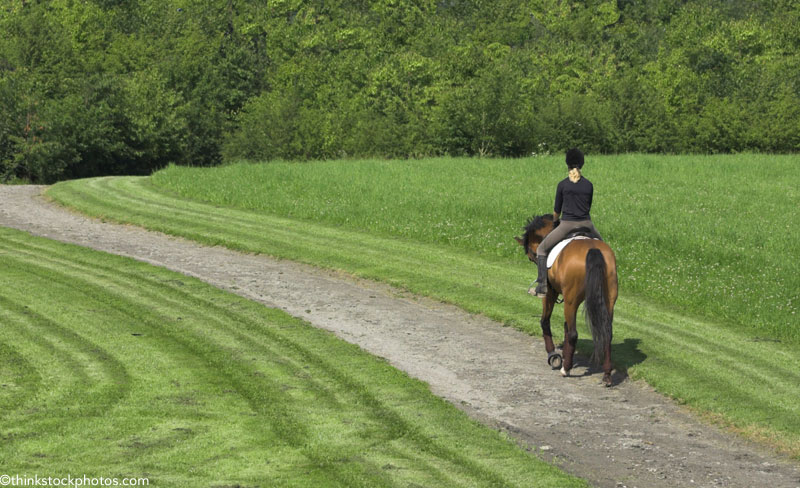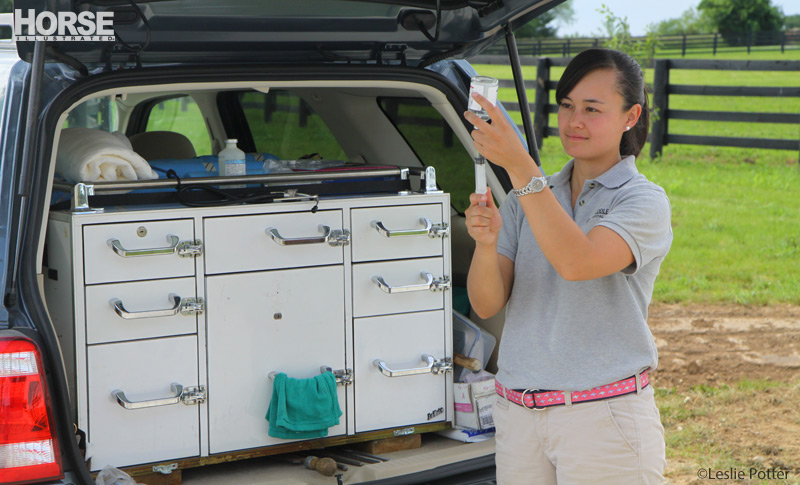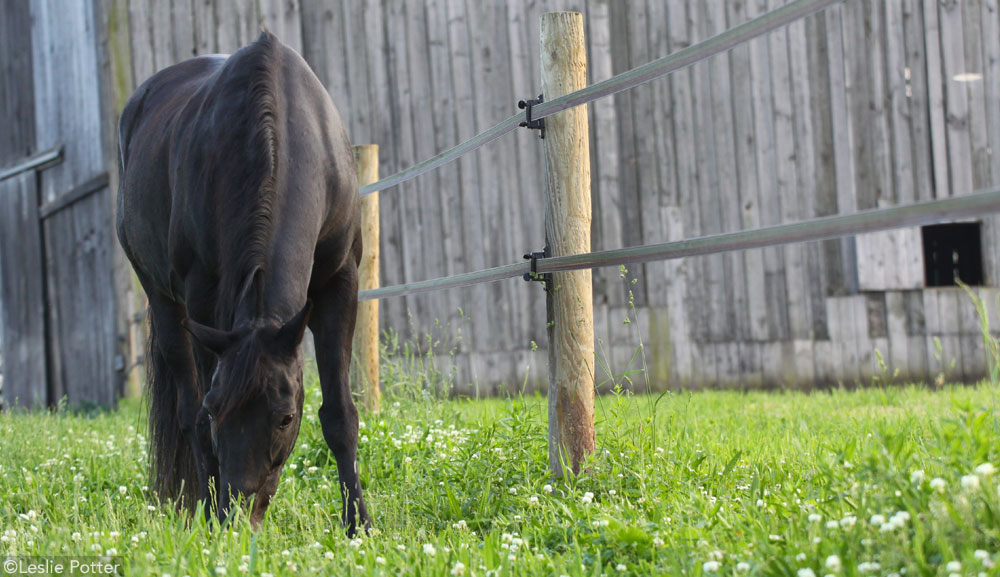Spring is around the corner and you can’t wait to get in the saddle for lots of riding time again. But first, you’ll need to get your equine partner primed and ready. Whether your horse had a long winter break or didn’t miss a beat, there are important health considerations that need to be taken care of annually. Address these tasks early on in the spring season by making an appointment with your vet for a spring visit so you can make the most of the prime riding months ahead with a fit, healthy horse.
- A spring veterinary appointment for your horse can cover vaccinations, Coggins test, dental exams, and other key equine wellness assessments.
- Riders should plan a careful conditioning schedule for their horses if they’ve been on a reduced riding schedule through the winter.
- Begin insect control procedures now before the height of fly season for best results.

Spring Vet Visit: Wellness Exam
A wellness check in the spring gives you a chance to talk to your veterinarian about the best strategies to keep your horse healthy and sound through the busy riding season.
During a spring vet visit or check-up, discuss your plans for the upcoming season and have your veterinarian do a wellness exam to evaluate your horse’s general health and body condition, as well as soundness.
She can advise you on your horse’s feeding plan and give recommendations for preventive care and appropriate parasite control. It’s also a good time to have your vet administer spring immunizations.

Spring Vet Visit: Vaccinations
Many viral diseases coincide with the season, since mosquitoes transmit equine encephalomyelitis (Eastern and Western forms) and West Nile virus.
When horses intermingle during competition and training, it presents an opportunity for organisms to pass from an infectious carrier horse that may not even be showing signs of illness to a susceptible individual. This is particularly true of respiratory viral infections, like influenza or rhinopneumonitis. Protection against these viruses is included in the spring vaccine series.
Tetanus vaccinations are given annually and tend to be included in the springtime vaccination group. With increased spring activity of wildlife, such as skunks and raccoons, it’s ideal timing to guard against rabies, another core vaccine.
In areas of the country where tick-borne Lyme disease is prevalent, a vaccine is recommended. While it’s currently only available with labeling for dogs, the seriousness of such an infection may warrant its use in horses.
Spring Vet Visit: Coggins
In addition to immunizations, a spring vet visit also includes “Coggins” testing for equine infectious anemia (EIA), which is potentially transmitted by large biting flies.
Travel across state lines requires a negative Coggins test, and many clinics and barns require this for entry onto the grounds. Because there is no vaccine for EIA, the only means of controlling transmission of this virus is via testing to identify carrier horses.
The Coggins test should be repeated annually, although some states require a negative Coggins test within six months of entry.
Spring Vet Visit: Parasite Control
With warming springtime temperatures, there is also an increased risk of exposure to internal parasites.
This is an ideal time to have your vet perform fecal egg counts during a spring vet visit to identify the parasite load each horse is carrying, and how well the deworming program done (or not done) during the winter has worked.
It’s also a good way to find out if a particular horse is a “high shedder” or “low shedder” of parasite eggs. A fecal sample collected after the previous deworming gives information that enables your veterinarian to provide guidance about a deworming strategy that takes into account your horse’s specific geographic location, climate and fecal egg count results.
There are two efforts: one is the egg reduction count, which is done two weeks after a deworming treatment in a horse that was found to be loaded with parasite eggs. This identifies if there is drug resistance.
The other is to see how a horse is doing 12 to 16 weeks following the previous deworming, which also determines if he is a low, medium, or high shedder, or is a non-shedder.
Dental Check-Up
Keeping up with dental care is important to your horse’s health. Proper dental care lets your horse chew his feed thoroughly for better digestive health and nutrient use. It also keeps your horse comfortable while being ridden with a bit.
At the very least, a dental exam should be done once or twice a year to keep your horse’s mouth in the best shape.

Feed Adjustments
Along with good dental care, good nutrition is important to enable your horse to perform at his physical best.
Check your hay for mold as you approach the end of last year’s supply. Hay that is overly dry or dusty can cause respiratory irritation. Open a bale and separate a flake; if it makes you cough, then your horse is likely to be similarly affected.
If mold isn’t present and the hay is simply dry, wet or soak it before feeding. To minimize the amount of dust and debris your horse inhales, offer the hay on the ground or below chest level rather than high up in a hay net or top-loaded feeder.
As you put more athletic demands on your horse, you may need to re-evaluate his feed. Changes in ration amounts and type of feed should be modified slowly over a 10- to14-day period to allow the digestive tract to adapt. Adding extra grass hay doesn’t usually require an adaptation period, but adding in alfalfa hay, grain, complete feed, and oil supplements do.
Caution in introducing a horse to spring pasture can save a lot of colic headaches. Start with 15 to 20 minutes a day, and gradually increase the grazing time. Adding 15 to 20 more minutes every five days is a good starting point.
Upon reaching an hour of turnout, time can be increased by 30 to 60 minute increments, depending on the quality of the pasture and the sensitivity of an individual horse’s gut.
Taking time to allow the horse’s intestinal flora to accommodate the rich spring forage helps to minimize digestive upset. It’s also wise to keep horses off pasture when it’s wet to avoid trampling the tender grass. Consult with your vet during your spring vet visit to decide which nutrition plan is right for your horse.
Hoof Care
You may have kept your horse barefoot through the winter and are now ready to have shoes put on him again. Make sure your horse is shod well in advance of important training or events so your farrier can fine-tune the horse’s angles in time for him to adapt to changes.
Wet ground tends to cause thrush or hoof abscesses in certain areas, so daily cleaning and topical application of an anti-thrush product can be helpful.
Conditioning
Bringing your horse back from a winter layoff relies on good common sense.
Start your training program slowly, with steady increases rather than asking your horse for strong efforts right away. Your plan should take into account whether he has enjoyed pasture turnout over the winter or has been confined to a stall. Moving around in turnout keeps tendons and muscles toned, and provides the foundation for a conditioning program.
A stalled or confined horse needs more time to leg up. A general rule is to increase walking periods by five minutes every three days, working up to at least an hour per day of walking.
Then trot can be added, and finally canter work. It’s always best to err on the side of caution, especially if your horse has been idle over the winter.
Pre-Season Insect Control
March is not too early to start thinking about insect control. Flies and mosquitoes spread infection and diseases, including potentially fatal viruses. A smart strategy is to stop the problem before it starts, and minimize populations.
Target mosquito breeding sites by eliminating or frequently draining containers that hold water: flower pots, old tires, birdbaths, buckets, wading pools, and pet food bowls, to name a few. Make sure that gutters drain well and there is good drainage around water tanks. Weekly application of “dunks” or “bits” in ponds and water tanks is a good control strategy. The products contain soil bacteria called Bacillus thuringiensis israelensis (BTI) or Bacillus sphaericus (BS), which deter hatching of mosquito larvae, blackflies and midges.
For fly control, there are companies that sell packages of non-stinging wasps called parasitoids (commercially known as as Fly Predators or Fly Eliminators). These beneficial insects feed on fly larvae, which reduces the number of flies hatching to adult form. The company mails you monthly (or weekly) shipments to release from spring until the first killing frost. It’s best to start releasing beneficial insects as early as possible in order to keep adult fly populations to a minimum.
The Bottom Line
Every horse should be treated as an individual to achieve optimal wellness. The best way to do this is to work closely with your vet and be sure to see your vet for a spring visit.
Preventive care is key, including immunization. Dental care, hoof care and good nutrition are all part of maximizing your horse’s health and performance.
This article originally appeared in the March 2017 issue of Horse Illustrated magazine. Click here to subscribe!





